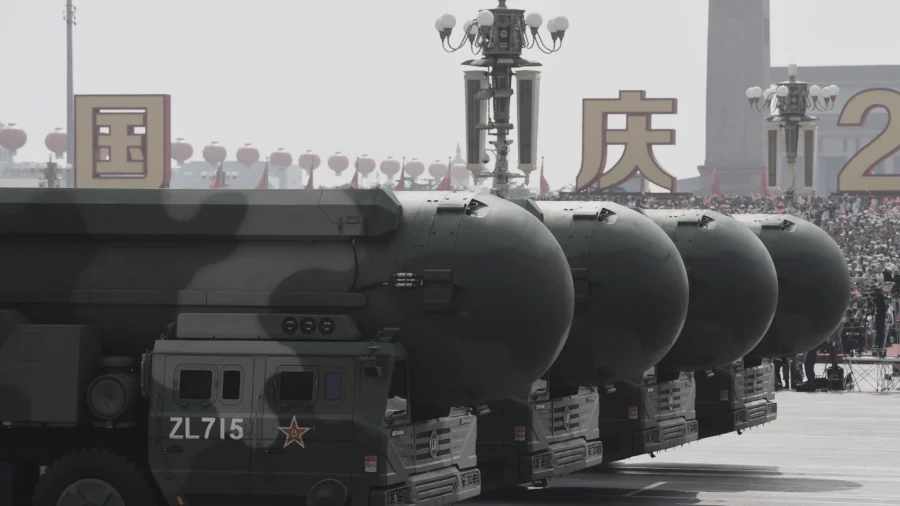China’s communist regime is expected to have the same number of intercontinental ballistic missiles—usually used as carriers of nuclear warheads—as the United States and Russia by 2030, according to a Swedish research center. However, the regime is expected to have fewer nuclear warheads than either the United States or Russia.
According to a new report by the Stockholm International Peace Research Institute (SIPRI), the number and types of nuclear weapons have increased worldwide, with China accounting for most of the new warheads.
“[The] size of China’s nuclear arsenal increased from 410 warheads in January 2023 to 500 in January 2024, and it is expected to keep growing,” SIPRI said in a June 17 media release.
In comparison, North Korea went from 30 to 50, while India’s inventory increased from 164 to 172 warheads. The United States has 3,708 warheads, while Russia has 4,380, according to the report.
“China is expanding its nuclear arsenal faster than any other country,” said Hans M. Kristensen from SIPRI and the Federation of American Scientists. “But in nearly all of the nuclear-armed states there are either plans or a significant push to increase nuclear forces.”
At the end of 2023, a Pentagon report also estimated China’s stock of warheads at 500, but said that the country is aiming for 1,000 warheads by the end of the decade.
Countries around the world are putting more emphasis on nuclear deterrence, and this year was the first time China is believed to have kept nuclear warheads on high operational alert.
There are now nine nuclear-armed countries, namely the United States, Russia, France, the United Kingdom, China, North Korea, Israel, India, and Pakistan. Of these, the United States and Russia hold 90 percent of currently existing nuclear warheads.
As of January 2024, there were an estimated 12,121 nuclear weapons in existence, with 9,585 of them expected to be operational and in stockpiles, and around 3,904 deployed with missiles or aircraft—60 more than in 2023, according to the SIPRI report.
Of those deployed, 2,100 were on high operational alert on ballistic missiles—which is about 100 more than the previous year, with nearly all belonging to the United States or Russia.
“While the global total of nuclear warheads continues to fall as cold war-era weapons are gradually dismantled, regrettably we continue to see year-on-year increases in the number of operational nuclear warheads,” said SIPRI Director Dan Smith. “This trend seems likely to continue and probably accelerate in the coming years and is extremely concerning.”
The credibility of the estimates for the number of nuclear weapons varies for each nuclear-armed country, however, according to the report. In some cases, the estimate is based on the amount of fissile material—plutonium and highly enriched uranium—a country produces, and on observation of its official missile numbers.
The United States, for example, declassified information on its nuclear stockpile in 2021, though this was not done for 2022 or 2023. The authors used publicly available information in order to reach their conclusions.
The United States had plans for increasing its production of new nuclear warheads from 10 plutonium cores per year to 30 cores in 2026 and 80 per year by 2030. However, the country acknowledged in 2022 that this timeline was unrealistic. The country’s nuclear forces include heavy bombers, intercontinental ballistic missiles, and ballistic missile-armed submarines. SIPRI estimates that some 3,508 nuclear weapons are deployed through these forces.
India, Pakistan, and North Korea are also pursuing the capability to deploy warheads on ballistic missiles, the report says.
As of January 2024, Russia had deployed 36 more warheads with operational forces than in January 2023.
The United States and Russia’s military stockpiles of nuclear warheads were stable in 2023, with each country having 1,200 warheads retired from their militaries that are gradually being dismantled.
Russia has also threatened nuclear war over Western help for Ukraine and, in May 2024, it deployed nuclear weapons and carried out drills near the Ukrainian border.
“We have not seen nuclear weapons playing such a prominent role in international relations since the cold war,” said Wilfred Wan, Director of SIPRI’s Weapons of Mass Destruction program. “It is hard to believe that barely two years have passed since the leaders of the five largest nuclear-armed states jointly reaffirmed that ‘a nuclear war cannot be won and must never be fought.’”
In 2023, France continued its program to develop a third-generation nuclear-powered ballistic missile submarine (SSBN) and a new air-launched cruise missile.
India slightly expanded its stockpile, with its main focus being the maintenance of a deterrent to Pakistan. However, it is also putting emphasis on longer-range weapons that could reach China.
“We are now in one of the most dangerous periods in human history,” said Dan Smith, SIPRI Director. “There are numerous sources of instability—political rivalries, economic inequalities, ecological disruption, an accelerating arms race. The abyss is beckoning and it is time for the great powers to step back and reflect. Preferably together.”

